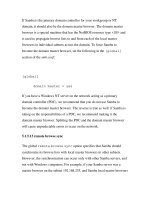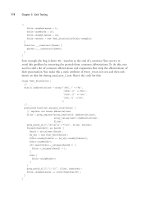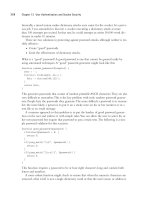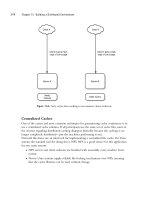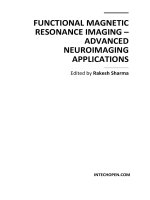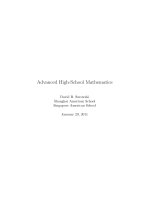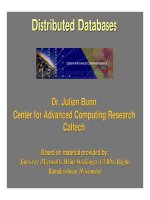advanced mathematical thinking edited pdf
Bạn đang xem bản rút gọn của tài liệu. Xem và tải ngay bản đầy đủ của tài liệu tại đây (1.9 MB, 310 trang )
www.EngineeringBooksPDF.com
ADVANCED MATHEMATICAL THINKING
www.EngineeringBooksPDF.com
Mathematics Education Library
VOLUME 11
Managing Editor
A.J. Bishop, Cambridge, U.K.
Editorial Board
H. Bauersfeld, Bielefeld, Germany
J. Kilpatrick, Athens, U.S.A.
G. Leder, Melbourne, Australia
S. Tumau, Krakow, Poland
G. Vergnaud, Paris, France
The titles published in this series are listed at the end of this volume.
www.EngineeringBooksPDF.com
ADVANCED
MATHEMATICAL THINKING
Edited by
DAVID TALL
Science Education Department,
University of Warwick
KLUWER ACADEMIC PUBLISHERS
NEW YORK / BOSTON / DORDRECHT / LONDON / MOSCOW
www.EngineeringBooksPDF.com
eBook ISBN:
Print ISBN:
0-306-47203-1
0-792-31456-5
©2002 Kluwer Academic Publishers
New York, Boston, Dordrecht, London, Moscow
All rights reserved
No part of this eBook may be reproduced or transmitted in any form or by any means, electronic,
mechanical, recording, or otherwise, without written consent from the Publisher
Created in the United States of America
Visit Kluwer Online at:
and Kluwer's eBookstore at:
www.EngineeringBooksPDF.com
TABLE OF CONTENTS
PREFACE
xiii
ACKNOWLEDGEMENTS
xvii
INTRODUCTION
CHAPTER 1 : The Psychology of Advanced Mathematical Thinking - David Tall
1.
2.
3.
4.
Cognitive considerations
1.1
Different kinds of mathematical mind
1.2
Meta-theoretical considerations
1.3
Concept image and concept definition
1.4
Cognitive development
1.5
Transition and mental reconstruction
1.6
Obstacles
1.7
Generalization and abstraction
1.8
Intuition and rigour
The growth of mathematical knowledge
2.1
The full range of advanced mathematical thinking
2.2
Building and testing theories: synthesis and analysis
2.3
Mathematical proof
Curriculum design in advanced mathematical learning
3.1
Sequencing the learning experience
3.2
Problem-solving
3.3
Proof
3.4
Differences between elementary and advanced
mathematical thinking
Looking ahead
www.EngineeringBooksPDF.com
3
4
4
6
6
7
9
9
11
13
14
14
15
16
17
17
18
19
20
20
vi
TABLE OF CONTENTS
I : THE NATURE OF
ADVANCED MATHEMATICAL THINKING
CHAPTER 2 : Advanced Mathematical Thinking Processes - Tommy Dreyfus
1.
2.
3.
4.
5.
Advanced mathematical thinking as process
Processes involved in representation
2.1
The process of representing
2.2
Switching representations and translating
2.3
Modelling
Processes involved in abstraction
3.1
Generalizing
3.2
Synthesizing
3.3
Abstracting
Relationships between representing and abstracting (in learning
processes)
A wider vista of advanced mathematical processes
CHAPTER 3 : Mathematical Creativity - Gontran Ervynck
1.
2.
3.
4.
5.
6.
7.
8.
9.
The stages of development of mathematical creativity
The structure of a mathematical theory
A tentative definition of mathematical creativity
The ingredients of mathematical creativity
The motive power of mathematical creativity
The characteristics of mathematical creativity
The results of mathematical creativity
The fallibility of mathematical creativity
Consequences in teaching advanced mathematical thinking
CHAPTER 4 : Mathematical Proof - Gila Hanna
1.
2.
3.
4.
5.
6.
Origins of the emphasis on formal proof
More recent views of mathematics
Factors in acceptance of a proof
The social process
Careful reasoning
Teaching
www.EngineeringBooksPDF.com
25
26
30
30
32
34
34
35
35
36
38
40
42
42
46
46
47
47
49
50
52
52
54
55
55
58
59
60
60
TABLE OF CONTENTS
vii
II: COGNITIVE THEORY
OF ADVANCED MATHEMATICAL THINKING
CHAPTER 5 : The Role of Definitions in the Teaching and Learning of
Mathematics - Shlomo Vinner
1.
2.
3.
4.
5.
6.
7.
8.
Definitions in mathematics and common assumptions about
Pedagogy
The cognitive situation
Concept image
Concept formation
Technical contexts
Concept image and concept definition - desirable theory and
practice
Three illustrations of common concept images
Some implications for teaching
CHAPTER 6 : The Role of Conceptual Entities and their symbols in building
AdvancedMathematicalConcepts - Guershon Harel & James Kaput
1.
2.
3.
Three roles of conceptual entities
1.1
Working-memory load
1.2a
Comprehension: the case of “uniform” and “point- wise”
operators
1.2b
Comprehension: the case of object-valued operators
1.3
Conceptual entities as aids to focus
Roles of mathematical notations
2.1
Notation and formation of cognitive
entities
2.2
Reflecting structure in elaborated notations
Summary
CHAPTER 7 : Reflective Abstraction in Advanced Mathematical Thinking Ed Dubinsky
65
65
67
68
69
69
69
73
79
82
83
84
84
86
88
88
89
91
93
95
1.Piaget’s notion of reflective abstraction
97
1.1
The importance of reflective abstraction
97
1.2
The nature of reflective abstraction
99
1.3
Examples of reflective abstraction in children’s thinking 100
1.4
Various kinds of construction in
reflective abstraction
101
2.
A theory of the development of concepts in advanced
mathematical thinking
102
www.EngineeringBooksPDF.com
...
viii
TABLE OF CONTENTS
3.
4.
2.1
Objects, processes and schemas
2.2
Constructions in advanced mathematical concepts
2.3
The organization of schemas
Genetic decompositions of three schemas
3.1
Mathematical induction
3.2
Predicate calculus
3.3
Function
Implications for education
4.1
Inadequacy of traditional teaching practices
4.2
What can be done
102
103
106
109
110
114
116
119
120
123
III : RESEARCH INTO THE TEACHING AND LEARNING
OF ADVANCED MATHEMATICAL THINKING
CHAPTER 8 : Research in Teaching and Learning Mathematics at an Advanced
Level - Aline Robert & Rolph Schwarzenberger
1.
2.
3.
Do there exist features specific to the learning of advanced
mathematics?
1.1
Social factors
1.2
Mathematical content
1.3
Assessment of students’ work
1.4
Psychological and cognitive characteristics of students
1.5
Hypotheses on student acquisition of knowledge in
advanced mathematics
1.6
Conclusion
Research on learning mathematics at the advanced level
2.1
Research into students’ acquisition of specific concepts
2.2
Research into the organization of mathematical content
at an advanced level
2.3
Research on the external environment for advanced
mathematical thinking
Conclusion
CHAPTER 9 : Functions and associated learning difficulties - Theodore
Eisenberg
1.
Historical background
2.
Deficiencies in learning theories
3.
Variables
4.
Functions, graphs and visualization
5.
Abstraction, notation, and anxiety
6.
Representational difficulties
www.EngineeringBooksPDF.com
127
128
128
128
130
131
132
133
133
134
134
136
139
140
140
142
144
145
148
151
TABLE OF CONTENTS
7.Summary
152
CHAPTER 10 : Limits - Bernard Cornu
1.
2.
3.
4.
5.
6.
Spontaneous conceptions and mental models
Cognitive obstacles
Epistemological obstacles in historical development
Epistemological obstacles in modem mathematics
The didactical transmission of epistemological obstacles
Towards pedagogical strategies
CHAPTER 11 : Analysis - Michèle Artigue
1.
2.
3.
4.
153
154
158
159
162
163
165
167
Historical background
168
1.1
Some concepts emerged early but were established late 168
1.2
Some concepts cause both enthusiasm and virulent
criticism
168
1.3
The differential/derivative conflict and its educational
repercussions
169
1.4
The non-standard analysis revival and its weak impact on
education
172
1.5
Current educational trends
173
Student conceptions
174
2.1
A cross-sectional study of the understanding of
elementary calculus in adolescents and young adults
176
2.2
A study of student conceptions of the differential, and
of the processes of differentiation and integration
180
2.2.1 The meaning and usefulness of differentials and
differential procedures
180
2.2.2 Approximation and rigour in reasoning
182
2.2.3 The role of differential elements
184
2.3
The role of education
186
Research in didactic engineering
186
3.1
"Graphic calculus"
187
3.2
Teaching integration through scientific debate
191
3.3
Didactic engineering in teaching differential equations
193
3.4
Summary
195
Conclusion and future perspectives in education
196
CHAPTER 12 : The Role of Students’Intuitions of Infinity in Teaching the
Cantorian Theory - Dina Tirosh
1.
ix
Theoretical conceptions of infinity
www.EngineeringBooksPDF.com
199
200
x
TABLE OF CONTENTS
2.
3.
4.
5.
Students’ conceptions of infinity
201
2.1
Students’ intuitive criteria for comparing infinite
quantities
203
First steps towards improving students’ intuitive understanding of
actual infinity
205
3.1
The "finite and infinite sets" learning unit
206
3.2
Raising students’ awareness of the inconsistencies in
their own thinking
206
3.3
Discussing the origins of students’ intuitions about
infinity
207
3.4
Progressing from finite to infinite sets
207
208
3.5
Stressing that it is legitimate to wonder about infinity
3.6
Emphasizing the relativity of mathematics
208
3.7
Strengthening students’ confidence in the new definitions 209
Changes in students’ understanding of actual infinity
209
Final comments
214
CHAPTER 13 : Research on Mathematical Proof - Daniel Alibert &
Michael Thomas
1.
2.
3.
4.
5.
Introduction
Students’ understanding of proofs
The structural method of proof exposition
3.1
A proof in linear style
3.2
A proof in structural style
Conjectures and proofs - the scientific debate in a mathematical
course
4.1
Generating scientific debate
4.2
An example of scientific debate
4.3
The organization of proof debates
4.4
Evaluating the role of debate
Conclusion
CHAPTER 14 : Advanced Mathematical Thinking and the Computer Ed Dubinsky and David Tall
1.
2.
3.
4.
5.
6.
215
215
216
219
221
222
224
225
226
228
229
229
231
Introduction
231
The computer in mathematical research
231
The computer in mathematical education - generalities
234
Symbolic manipulators
235
Conceptual development using a computer
237
The computer as an environment for exploration of fundamental
ideas
238
www.EngineeringBooksPDF.com
TABLE OF CONTENTS
7.
8.
Programming
The future
xi
241
243
Appendix to Chapter 14
ISETL : a computer language for advanced mathematical thinking
244
EPILOGUE
CHAPTER 15 : Reflections - David Tall
251
BIBLIOGRAPHY
261
INDEX
275
www.EngineeringBooksPDF.com
This page intentionally left blank.
www.EngineeringBooksPDF.com
PREFACE
Advanced Mathematical Thinking has played a central role in the development of human
civilization for over two millennia. Yet in all that time the serious study of the nature of
advanced mathematical thinking – what it is, how it functions in the minds of expert
mathematicians, how it can be encouraged and improved in the developing minds of
students – has been limited to the reflections of a few significant individuals scattered
throughout the history of mathematics. In the twentieth century the theory of mathematical
education during the compulsory years of schooling to age 16 has developed its own body
of empirical research, theory and practice. But the extensions of such theories to more
advanced levels have only occurred in the last few years.
In 1976 The International Group for the Psychology of Mathematics (known as PME)
was formed and has met annually at different venues round the world to share research
ideas. In 1985 a Working Group of PME was formed to focus on Advanced Mathematical
Thinking with a major aim of producing this volume.
The text begins with an introductory chapter on the psychology of advanced mathematical thinking, with the remaining chapters grouped under three headings:
• the nature of advanced mathematical thinking,
• cognitive theory,
and
• reviews of the progress of cognitive research into different areas of advanced
mathematics.
It is written in a style intended both for mathematicians and for mathematics educators, to
encourage an interest in the cognitive difficulties experienced by students of the former and
to extend the psychological theories of the latter through to later stages of development. We
are cognizant of the fact that it is essential to understand the nature of the thinking of
mathematical experts to see the full spectrum of mathematical growth. We therefore begin
with an introductory chapter on the psychology of advanced mathematical thinking. This
is followed by three chapters which focus on the nature of advanced mathematical thinking:
a study of the mental processes involved, the essential qualities of mathematical creativity
and the mathematician’s view of proof.
The processes prove to be subtle and complex and, sadly, few of the more advanced
processes are made available to the average student in an advanced mathematical course.
Creativity is concerned with how the subtle ideas of research are built in the mind. Proof
is how they are ordered in alogical development both to verify the nature of the relationships
and also to present them for approval to the mathematical community.
xiii
www.EngineeringBooksPDF.com
xiv
PREFACE
However, there is a huge gulf between the way in which ideas are built cognitively and
the way in which they are arranged and presented in a deductive order. This warns us that
simply presenting a mathematical theory as a sequence of definitions, theorems and proofs
(as happens in a typical university course) may show the logical structure of the
mathematics, but it fails to allow for the psychological growth of the developing human
mind.
We begin the part of the book on cognitive theory by considering the way in which
formal mathematical definitions are conceived by students and how this can be at variance
with the formal theory. As a result of mentally manipulating a (mathematical) concept an
individual develops an idiosyncratic personal concept image which is the product of
experience and mental activity. Empirical research shows how this can give rise to subtle
conflicts that can cause cognitive obstacles in the mind of the developing student and act
as a barrier to attaining the formal ideas in the theory. The next chapter looks at the mental
objects that arc the material of mathematical thought – the conceptual entities that are
manipulated in the mind during advanced mathematical thinking, and how these entities
are represented by different kinds of symbolism. The final chapter in this part considers how
these conceptual entities are formed – through the process of reflective abstraction. All
advanced mathematical concepts arc “abstract”. This chapter postulates a theory of how
these concepts start as processes which are encapsulated as mental objects that are then
available for higher level abstract thought. Such a theory can give insight into how
mathematicians develop advanced mathematical ideas, yet may fail to pass these thinking
processes on to students, and what might be done to improve the situation.
The remainder of the book is concerned with overviews of empirical research and theory
in various specific topics. First the question of the nature of advanced mathematical
thinking is addressed and how (if at all) it differs from more elementary thinking occurring
in younger children. Then there follow chapters on functions, limits, analysis, infinity,
proof, and the growing use of the computer in advanced mathematics. Each one of these
reveals a wide variety of obstacles in students’ mental imagery and often extremely limited
conceptions of formal concepts which are the unforseen consequences of the manner in
which the subject is presented to the student. A variety of more cognitively appropriate
approaches are postulated, some with empirical evidence of success. These include:
• the participation of the student in the process of mathematical thinking through
an active process of “scientific debate”, rather than passive receipt of preorganized theory,
• the direct confrontation of the student with conflict which occurs in developing
new theoretical constructs, to help them reflect on the problem and build a new,
more coherent, cognitive structure.
• the building up of appropriate intuitive foundations for the advanced mathematical concepts, through an approach which balances cognitive growth and
an appreciation of logical development.
• the use of visualization, particularly utilizing a computer, to give the student an
overall view of concepts and enabling more versatile methods of handling the
information,
www.EngineeringBooksPDF.com
PREFACE
xv
• the use of programming to cause the student to think through mathematical
processes in a way which can be encapsulated by reflective abstraction.
In all these ways we believe that empirical research into advanced thinking processes
related to complementary cognitive theory can have a significant effect in improving the
education of students at an advanced level.
In every chapter the authors have been encouraged to impress their own personalities
on their view of the phenomena, but this has been done within a framework of internal
consultation. Each participant operates from personal constructs within a context of mutual
support and constructive criticism from other authors and the final manuscript has been
recast by the editor to enable it to be read throughout as a single text rather than as a
collection of disconnected papers. This was made possible through the wonders of modem
technology, using a Macintosh SE/30 computer to enable the editor to redraft the chapters
and set the whole book as camera-ready copy.
The cognitive theory of advanced mathematical thinking is developing apace. This
study is the first step in making the broad sweep of current ideas in the advanced
mathematical education community available to a wider readership.
David Tall
www.EngineeringBooksPDF.com
This page intentionally left blank.
www.EngineeringBooksPDF.com
ACKNOWLEDGEMENTS
In preparing this book we acknowledge the assistance and support of a wide range of
mathematicians and mathematics educators. First we thank the International Committee of
PME for encouraging us to meet each year as a continuing Working Group of PME. Then
we thank those members of the Working Group who do not appear as authors but who have
helped in many ways – presenting papers, organizing and reporting sessions – including
Janet Duffin, Ulla Kürstein-Jensen, Miriam Amit, Anna Sfard, Janine Rogalski. Within the
group of authors, all have participated in criticizing and encouraging the writing of others.
However, it is with grateful thanks that the editor wishes to acknowledge assistance beyond
the call of duty from Tommy Dreyfus, Ted Eisenberg, Ed Dubinsky, and particularly from
Gontran Ervynek, whose enthusiasm generated the original impetus for the creation of this
book.
xvii
www.EngineeringBooksPDF.com
This page intentionally left blank.
www.EngineeringBooksPDF.com
INTRODUCTION
www.EngineeringBooksPDF.com
This page intentionally left blank.
www.EngineeringBooksPDF.com
CHAPTER 1
THE PSYCHOLOGY
OF
ADVANCED MATHEMATICAL THINKING
DAVID TALL
In the opening chapter of The Psychology of Invention in the Mathematical Field, the
mathematician Jacques Hadamard highlighted the fundamental difficulty in discussing the
nature of the psychology of advanced mathematical thinking:
... that the subject involves two disciplines, psychology and mathematics, and would require, in
order to be treated adequately, that one be both a psychologist and a mathematician. Owing to the
lack of this composite equipment, the subject has been investigated by mathematicians on the one
side, by psychologists on the other ...
(Hadamard, 1945, page 1.)
Exponents of the two disciplines are likely to view the subject in different ways – the
psychologist to extend psychological theories to thinking processes in a more complex
knowledge domain – the mathematician to seek insight into the creative thinking process,
perhaps with the hope of improving the quality of teaching or research. Although we will
consider the nature of advanced mathematical thinking from a psychological viewpoint,
our main aim will be to seek insights of value to the mathematician in his professional work
as researcher and teacher.
We begin by looking at pertinent psychological considerations which will lay the
foundations for ideas introduced not only in the remainder of the chapter, but in the book
as a whole. We then focus our attention on the full cycle of activity in advanced math–
ematical thinking: from the creative act of considering a problem context in mathematical
research that leads to the creative formulation of conjectures and on to the final stage of
refinement and proof. We postulate that many of the activities that occur in this cycle also
occur in elementary mathematical problem-solving, but the possibility of formal definition
and deduction is one factor which distinguishes advanced mathematical thinking. We will
also find that teaching undergraduate mathematics often presents the final form of the
deduced theory rather than enabling the student to participate in the full creative cycle. In
the words of Skemp (1971), current approaches to undergraduate teaching tend to give
students the product of mathematical thought rather than the process of mathematical
thinking.
Not only may current methods of presenting advanced mathematical knowledge fail to
give the full power of mathematical thinking, it also has another, equally serious,
deficiency: a logical presentation may not be appropriate for the cognitive development
of the learner. Indeed, much of the empirical theory reported in the later chapters of the book
reveals cognitive obstacles which arise as students struggle to come to terms with ideas
which challenge and contradict their current knowledge structure. Fortunately, we are also
able to report empirical evidence that appropriate sequences of learning and instruction
designed to help the student actively construct the concepts can prove highly successful.
3
www.EngineeringBooksPDF.com
4
DAVID TALL
1. COGNITIVE CONSIDERATIONS
We begin by looking, not at the logic and order of the public evidence of mathematical
thinking found in research articles and text-books, but at the way in which these coherent
relationships are built in mathematical research and implications for how this might be
implemented in teaching and learning.
1.1 DIFFERENT KINDS OF MATHEMATICAL MIND
Writing in the first decade of this century, the celebrated mathematician Henri Poincaré
asserted:
It is impossible to study the works of the great mathematicians, or even those of the lesser,
without noticing and distinguishing two opposite tendencies, or rather two entirely different kinds
of minds. The one sort are above all preoccupied with logic; to read their works, one is tempted to
believe they have advanced only step by step, after the manner of a Vauban1 who pushes on his
trenches against the placebesieged, leaving nothing to chance. The other sort are guided by intuition
and at the first stroke make quick but sometimes precarious conquests, like bold cavalrymen of the
advanced guard.
(Poincaré, 1913, p. 210)
He supported his arguments by contrasting the work of various mathematicians, including
the famous German analysts, Weierstrass and Riemann, relating this to the work of
students:
Weierstrass leads everything back to the consideration of series and their analytic transformations;
to express it better, he reduces analysis to a sort of prolongation of arithmetic; you may turn through
all his books without finding a figure. Riemann, on the contrary, at once calls geometry to his aid;
each of his conceptions is an image that no one can forget, once he has caught its meaning.
... Among our students we notice the same differences; some prefer to treat their problems ‘by
analysis’, others ‘by geometry’. The first are incapable of ‘seeing in space’, the others are quickly
tired of long calculations and become perplexed.
(Poincaré, 1913, p. 212)
Of course, therearenotjust two different kinds of mathematical mind, but many. Kronecker
agreed with Weierstrass that logical proof was of paramount importance and transcended
intuitive visual arguments, but their fundamental beliefs in the nature of mathematical
concepts were very different. Weierstrass declared that “an irrational number has as real an
existence as anything else in the world of concepts”, but Kronecker was unable to accept
the actual infinity of real numbers, asserting that “God gave us the integers, the rest is the
work of man”. Based on the Weierstrassian notion of the actual infinity of real numbers,
Cantor was able to produce an infinite counting argument to show that there are strictly
“more” real numbers than algebraic numbers (solutions of polynomial equations with
integer coefficients). He therefore claimed that there exists a real non-algebraic number,
without giving an explicit method to construct one. This was anathema to Kronecker who
caused Cantor’s paper to be rejected from publication in Crelle’s Journal in 1873.
1
Sebastien de Vauban (1633-1707) was a French military engineer who revolutionized the art
of siege craft and defensive fortifications.
www.EngineeringBooksPDF.com
THE PSYCHOLOGY OF ADVANCED MATHEMATICAL THINKING
5
Such arguments about the foundations of mathematics led to the development of several
different strands of mathematical philosophy at the beginning of the twentieth century. The
intuitionist view represented by Kronecker asserted that mathematical concepts only exist
when their construction is demonstrated from the integers, the formalist view of Hilbert
affirmed that mathematics is the meaningful manipulation of meaningless marks written
on paper, whilst the logicist view of Russell, declared that mathematics consists of
deductions using the laws of logic.
Practising mathematicians tend to distance themselves from esoteric arguments and
simply get on with their work of stating and proving theorems. Thus the twentieth century
has seen the demise of Kronecker’s views and the triumph of a pragmatic mixture of
formalism and logic. It has seen the creation of a large number of formal systems based on
logical deduction from formal definitions and axioms – an approach that survived the
apparently mortal blow struck by Gödel’s incompleteness theorem, that any axiomatic
system including the integers must contain true statements that cannot be proved by a finite
sequence of steps within the system.
The textbook by Bishop (1967) on constructive analysis – which insists on algorithmic
construction proofs and disallows proof by contradiction alone – seems but an isolated
singularity in the dynamic flow of twentieth century mathematical creativity.
Nevertheless, the recent introduction of computer technology may yet see a new
renaissance in constructibility because of the way that computers manipulate data:
Computers have affected mathematics as inevitably as the development of railroads affected
patterns of land development. With computers it is possible to test hypotheses and compile data with
ease that formerly would have been accessible, if at all, only via the most sophisticated techniques.
This has affected not only the sort of questions that mathematicians work on, but the very way that
they think. One has to ask oneself which examples can be tested on a computer, a question which
forces one to consider concrete algorithms and to try to make them efficient. Because of this and
because algorithms have real-life applications of considerable importance, the development of
algorithms has become a respectable topic in its own right.
(Edwards, 1987)
The reason for raising these differences in mathematician’s perceptions is to heighten the
readers’ awareness of their own part in life’s rich tapestry, with a personal view of
mathematics that will differ in many ways from the conceptions of others. It may come as
a surprise when one first realizes that other people have radically different thinking
processes. It happened to the author when using pictures to help students visualize ideas in
mathematical analysis, at a time when he did not question the implicit belief that such an
approach was universally valid. Whilst writing a text book on complex analysis, a colleague
in the next room was engaged on a similar enterprise, yet the latter’s book had almost no
pictures at all. He only included a diagram illustrating the argument of a complex number
after a great deal of heart searching. To him a real number was an element of a complete
ordered field (satisfying specific axioms) and a complex number was an ordered pair of real
numbers. The argument of a complex number (x,y) wasdefined asareal number a such that
cos (α) =
sin (α) =
www.EngineeringBooksPDF.com
6
DAVID TALL
where sin and cos were defined by red power series. The theory did not require a
geometrical meaning. He took this hard line to make sure that his arguments were the
product of logical deduction and not dependent anywhere on geometric intuition. At the
time the author was sympathetic to this philosophical viewpoint, but considered it too
sophisticated for students. It was some considerable time later that the realization dawned
that not all students shared the geometric point of view. No one view holds universal sway.
1.2 META-THEORETICAL CONSIDERATIONS
The discussion of the preceding session is a salutary reminder that any theory of the
psychology of learning mathematics must take into account not only the growing
conceptions of the students, but the conceptions of mature mathematicians. Mathematics
is a shared culture and there are aspects which are context dependent. For example, an
analyst’s view of a differential may be very different ftom that of an applied mathematician,
and a given individual may strike up different attitudes to this concept depending on
whether it is considered in an analytic or applied context. We will see (chapter 11) that such
attitudes can cause conflicts in students too.
At a far deeper psychological level we all have subtly different ways of viewing a given
mathematical concept, depending on our previous experiences. For example, the “completeness axiom” for the real numbers is viewed by some as “filling in all the gaps between
the rational numbers to give all the points on the number line”. Such a view may imply that
there is “no room” to fit in any more numbers: the number line is now “complete”. The
“real” number line, in particular cannot contain “infinitesimals” which are smaller than any
positive rational yet not zero. But, for others, “completion” is only a technical axiom to
adjoin the limit points of cauchy sequences of rational numbers. In this case it is perfectly
possible to embed the real numbers in a variety of larger number fields, which include
infiitesimals and infinite numbers. It is this view which leads to the modern infinitesimal
theory of “non-standard analysis”. The latter idea, however, is anathema to many
mathematicians, including Cantor, who denied the existence of infinitesimals on the
grounds that it was not possible to calculate the reciprocal of an infiite number in his theory
of cardinal infinities. Even today many mathematicians are troubled by the infinitesimal
ideas of non-standard analysis; they may not deny its logic, but they sense a deep-seated
psychological unease as to its validity.
Thus any theory of the psychology of mathematical thinking must be seen in the wider
context of human mental and cultural activity. There is not one true, absolute way of
thinking about mathematics, but diverse culturally developed ways of thinking in which
various aspects are relative to the context.
1.3 CONCEPT IMAGE AND CONCEPT DEFINITION
In Tall & Vinner (1981). the distinction is made between the individual’s way of thinking
of a concept and its formal definition, thus distinguishing between mathematics as a mental
activity and mathematics as a formal system. This theory applies to expert mathematicians
as well as developing students:
www.EngineeringBooksPDF.com
